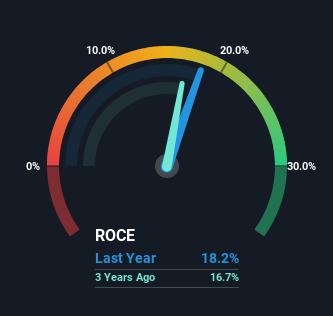Be Wary Of Indigo Paints (NSE:INDIGOPNTS) And Its Returns On Capital
What trends should we look for it we want to identify stocks that can multiply in value over the long term? Firstly, we'll want to see a proven return on capital employed (ROCE) that is increasing, and secondly, an expanding base of capital employed. Basically this means that a company has profitable initiatives that it can continue to reinvest in, which is a trait of a compounding machine. Having said that, from a first glance at Indigo Paints (NSE:INDIGOPNTS) we aren't jumping out of our chairs at how returns are trending, but let's have a deeper look.
What Is Return On Capital Employed (ROCE)?
Just to clarify if you're unsure, ROCE is a metric for evaluating how much pre-tax income (in percentage terms) a company earns on the capital invested in its business. The formula for this calculation on Indigo Paints is:
Return on Capital Employed = Earnings Before Interest and Tax (EBIT) ÷ (Total Assets - Current Liabilities)
0.18 = ₹1.8b ÷ (₹13b - ₹2.9b) (Based on the trailing twelve months to June 2024).
Thus, Indigo Paints has an ROCE of 18%. On its own, that's a standard return, however it's much better than the 14% generated by the Chemicals industry.
Check out our latest analysis for Indigo Paints

Above you can see how the current ROCE for Indigo Paints compares to its prior returns on capital, but there's only so much you can tell from the past. If you're interested, you can view the analysts predictions in our free analyst report for Indigo Paints .
How Are Returns Trending?
In terms of Indigo Paints' historical ROCE movements, the trend isn't fantastic. Around five years ago the returns on capital were 25%, but since then they've fallen to 18%. Although, given both revenue and the amount of assets employed in the business have increased, it could suggest the company is investing in growth, and the extra capital has led to a short-term reduction in ROCE. If these investments prove successful, this can bode very well for long term stock performance.
On a related note, Indigo Paints has decreased its current liabilities to 23% of total assets. So we could link some of this to the decrease in ROCE. Effectively this means their suppliers or short-term creditors are funding less of the business, which reduces some elements of risk. Some would claim this reduces the business' efficiency at generating ROCE since it is now funding more of the operations with its own money.
Our Take On Indigo Paints' ROCE
Even though returns on capital have fallen in the short term, we find it promising that revenue and capital employed have both increased for Indigo Paints. These growth trends haven't led to growth returns though, since the stock has fallen 36% over the last three years. So we think it'd be worthwhile to look further into this stock given the trends look encouraging.
While Indigo Paints doesn't shine too bright in this respect, it's still worth seeing if the company is trading at attractive prices. You can find that out with our FREE intrinsic value estimation for INDIGOPNTS on our platform.
For those who like to invest in solid companies, check out this free list of companies with solid balance sheets and high returns on equity.
Have feedback on this article? Concerned about the content? Get in touch with us directly. Alternatively, email editorial-team (at) simplywallst.com.
This article by Simply Wall St is general in nature. We provide commentary based on historical data and analyst forecasts only using an unbiased methodology and our articles are not intended to be financial advice. It does not constitute a recommendation to buy or sell any stock, and does not take account of your objectives, or your financial situation. We aim to bring you long-term focused analysis driven by fundamental data. Note that our analysis may not factor in the latest price-sensitive company announcements or qualitative material. Simply Wall St has no position in any stocks mentioned.
 Index Options
Index Options CME Group
CME Group Nasdaq
Nasdaq Cboe
Cboe TradingView
TradingView Wall Street Journal
Wall Street Journal